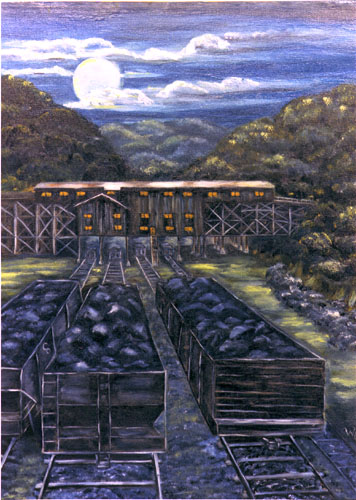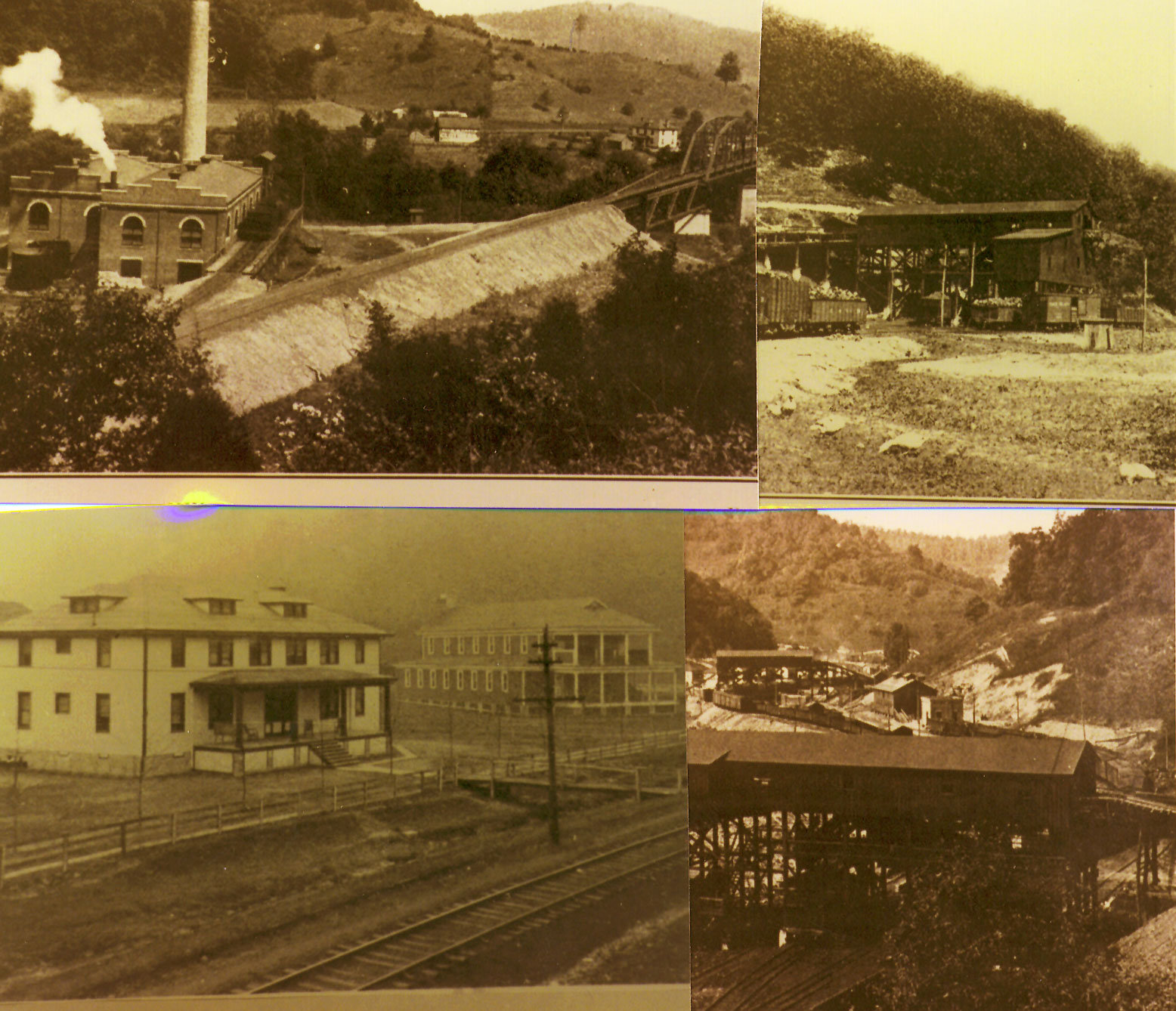Click here to take an Eighth-Grade Graduation test from the 1890s era.
Visit the Van Lear Historical Society Miners' Museum, a "Bootstrap Work-in-Progress.
Scroll on down for more "Old Van Lear."

- MINERS' MUSEUM (Call for appointment to visit)
- The miners' museum continues to grow as old-timers and their descendants donate tools once used in the Van Lear mines by members of their families. Old carbide lamps, breast augers, and other such items are featured.
- MODEL OF THE TOWN AS IT APPEARED IN THE 1930s
- A thirty-foot-long model, moved from Arkansas in 1989 to its present location on the third floor former meeting room of the Masons, has become a popular attraction.
- VETERANS WALL OF FAME
- Another popular museum feature is the wall of photos of native Van Learites who served our country in time of war. It has been said that Johnson County mothers sent more sons off to World War II than any other county in the United States. Someone should have told Tom Brokaw when he wrote THE GREATEST GENERATION.
- RESTORED C&O RAILROAD CABOOSE
- Thanks to Charles Spears, Bill Rucker, and others, an old C&O caboose has been refurbished in a "Mini Park" recreational area in front of the former site of the old high school, hotel, and Baptist Church.
- VIDEO DOCUMENTARY
- A 45-minute video documentary featuring photos and interviews with old-timers may be seen (by appointment) in the Verne P. Horne education room. A copy has also been donated to the Ky Historical Society at Frankfort. An updated video has been produced by Ronnie Blair, and may be purchased through the historical society.
- LORETTA LYNN'S CHILDHOOD HOME
- The home that Loretta Webb Lynn lived in during a portion of her childhood still stands about one mile up "Butcher Holler," a short distance east of the site of old Consolidation Mine #155. Her brother Herman provides personal tours by appointment.
- The miners' museum continues to grow as old-timers and their descendants donate tools once used in the Van Lear mines by members of their families. Old carbide lamps, breast augers, and other such items are featured.
Back to the top.
Click here to take an Eighth-Grade Graduation test from the 1890s era.
Click here to continue your stroll down memory lane, or scroll on down.
After viewing this page, click on the hotlink to our final pages. If you visited our website earlier, thanks for coming back. We've added a few things. If you're a first-time visitor, welcome. We hope you will enjoy this visit to our virtual-museum webpage. For more than twenty years, a small group of volunteers has endeavored to preserve some of Van Lear's past history. During the early years, these unpaid volunteers attempted to offer tours of the museum by appointment. Both a school and town reunion were staged when enough volunteer help could be assembled. It is our understanding that another school reunion may be held the first Saturday in August 2006. For a modest annual contribution of $10, you can become a member of The Van Lear Historical Society, which includes a subscription to THE BANKMULE. Recent donations have enabled VLHS to purchase its own printing equipment, which has resulted in an improved product and more timely delivery. It is highly advisable to call a member of the historical society well in advance of your visit to set up an appointment if you wish to visit the museum. Try calling 606-789-9725, write VLHS, Box 369, Van Lear KY 41265, or e-mail blevinstar@yahoo.com
Continue to scroll on down, or click here for photos of some old Van Lear structures.
The sepia-toned images you see on this page have been reproduced from some old photos of Van Lear structures as they appeared in the 1920s and 1930s, the two decades that represented this company-built town's heyday. Upper left is the coal-fired, steam-generated electric power plant at "The River" with the Mine #151 wooden tipple (coal-processing and loading facililty) pictured to the right. At the lower left are the Club House and Recreation Building, with tipples for Mines #153 and #154 at the lower right. All of these structures have been torn down, but are represented on the scale model of the town which may be seen on the third floor of the museum building. The electric power plant, built in 1912, was for its time one of the finest such facilities in the Commonwealth of Kentucky, supplying electricity in Van Lear and, for a time, to the county seat town of Paintsville. An early ambition of the historical society was the erection of descriptive markers at these and other historic sites; however these goals have been shelved temporarily. Again, if you plan a visit, be sure to call ahead. See the addresses and numbers on our final pages. Click anywhere on the old sepia photos at the left to enter our main portal.
James E. Vaughan was born and reared in eastern Kentucky. He attended Michigan State College and served in the U. S. Navy during World War II, achieving the rank of lieutenant (jg). He received his BA in mathematics and physics from Oklahoma University in 1947, and his MSE degree in 1962. He managed a commercial broadcast station in Miami, Florida for a time before moving with his wife Wanda Lee to an Arkansas farm in 1955, where he lived for 50 years, teaching and writing. He was member of the Arkansas Educational Telecommunications Commission from 1980 to 1988, and played a major role in establishing a statewide academic competition known as Quiz Bowl, which endures to this day.
"A Study of Vocabulary Improvement Techniques" was published in the NSPI Journal No. 6 in 1968. Over a period of some twenty years he authored more than 60 instructional books, including Mr. Ready and Mr. Phun Phonics (AudioActive, 1975). Ceres: A Space Odyssey, a software program for Apple II computers, was included in NASA's Second Edition of Software for Aerospace Education in 1990 (p.24, Section 1). His first work of fiction, a political story titled The Polemicists, won the 1993 Heartland Writers' Guild award for Contemporary Fiction. In 1996 his mystery story, The Case of La Grande Dame, was selected from more than 300 submissions to The New Yorker magazine for publication in an anthology. His Bankmules: The Story of Van Lear, a Kentucky Coal Town was published in 2003 by Jesse Stuart Foundation. The Alchymist and The Silurist is his first published novel.
1890s Eighth Grade Exam
The following exam was given to candidates for graduation from Eighth Grade classes in a number of states in the 1890s. Five hours was the allotted time to complete this exam, which was administered without access to notes or other reference materials. After taking the exam, click on the link for acceptable answers, but no fair peeking beforehand. Then decide what you think about today’s public schools? No, we didn't take this exam when I graduated from Van Lear's Eighth grade in 1939. Our parents did, back in the 1890s. Some state exams had only 48 questions. If you attempt to answer these 53 questions, sit down with pencil and paper—no books or PCs for reference—and allot five hours to the task.
1. Give nine rules for the use of capital letters.
18. Find bank discount on $300 for 90 days (no grace) at 10 per cent.
36. Mark diacritically and divide into syllables the following, and name the sign that indicates the sound: card, ball, mercy, sir, odd, cell, rise, blood, fare, and last.
Yahoo! is a registered trademark of Yahoo! Inc. This web site was last updated January 19, 2009, and is hosted by Yahoo!/Geocities.
If your PC is not presently equipped to play our music, click here to download Crescendo.

For a fast-loading, general-purpose alphabetized index/directory to the Internet, click on E-lynks or GOOGLE, using the search form below:
2. Name the parts of speech and define those that have no modifiers.
3. Define verse, stanza, and paragraph.
4. What are the principal parts of a verb? Give the principal parts of "lie," "play," and "run."
5. Define case; illustrate each case.
6. What is punctuation? Give rules for principal marks of punctuation.
7-10. Write a composition of about 150 words and show therein that you understand the practical use of the rules of grammar.
11. Name and define the fundamental rules of arithmetic.
12. A wagon box is 2 ft. deep, 10 feet long, and 3 ft. wide. How many bushels of wheat will it hold?
13. If a load of wheat weighs 3942 lbs, what is it worth t 50cts/bushel, deducting 1050 lbs for tare?
14. District No. 33 has a valuation of $35,000. What is the necessary levy to carry on a school seven months at $50 per month, and have $104 for incidentals?
15. Find the cost of 6720 lbs of coal at $6.00 per ton.
16. Find the interest of $512.60 for 8 months and 18 days at 7 per cent.
17. What is the cost of 40 boards 12 inches wide and 16 ft. long at $20 per meter?
19. What is the cost of a square farm at $15 per acre, the distance of which is 640 rods?
20. Write a Bank Check, a Promissory Note, and a Receipt.
21. Give the epochs into which U. S. History is divided.
22. Give an account of the discovery of America by Columbus.
23. Relate the causes and results of the Revolutionary War.
24. Show the territorial growth of the United States.
25. Tell what you can of the history of the state of Kansas.
26. Describe three of the most prominent battles of the Rebellion.
27. Who were the following: Morse, Whitney, Fulton, Bell, Lincoln, Penn, and Howe?
28. Name events connected with the following dates: 1607, 1620, 1800, 1849, and 1865.
29. What is meant by alphabet, phonetics, orthography, etymology, and syllabication?
30. What are elementary sounds? How are they classified?
31. What are the following, and give examples of each: trigraph, subvocals, diphthong, cognate letters, and linguals.
32. Give four substitutes for caret 'u.'
33. Give two rules for spelling words with final 'e.' Name two exceptions under each rule.
34. Give two uses of silent letters in spelling; illustrate each.
35. Define the following prefixes and use in connection with a word: bi, dis, mis, pre, semi, post, non, inter, mono, sup.
37. Use the following correctly in sentences: cite', site, sight, fane, fain, feign, vane, vain, vei n, raze, raise, rays.
38. Write 10 words frequently mispronounced and indicate pronunciation by use of diacritical marks and by syllabication.
39. What is climate? Upon what does climate depend?
40. How do you account for the extremes of climate in the state of Kansas?
41. Of what use are rivers? Of what use is the ocean?
42. Name and describe the major mountains of North America.
43. Name and describe the following: Monrovia, Odessa, Denver, Manitoba, Hecia, Yukon, St. Helena, Juan Fernandez, Aspinwall, and Orinoco.
44. Name and locate the principal trade centers of the U.S.
45. Name five republics of Europe and their capital cities.
46. Why is the Atlantic Coast colder than the Pacific in the same latitudes?
47. Describe the process by which the water of the ocean returns to the sources of rivers.
48. Describe the movements of the earth. Give the inclination of the earth in degrees.
49. Where are the saliva, gastric juice, and bile secreted? What is the use of each in digestion?
50. How does nutrition reach the circulation?
51. What is the function of the liver? Of the kidneys?
52. How would you stop the flow of blood from an artery in the case of laceration?
53. Give some general directions that you think would be beneficial to preserve the human body in a state of health.
To check your answers to the 8th-grade exam, click here.